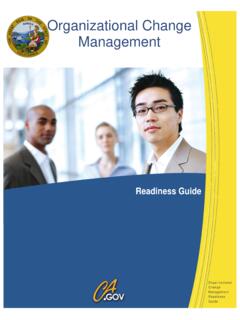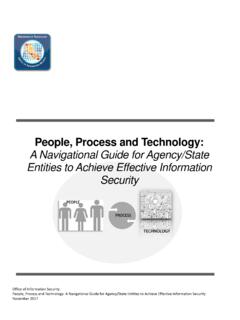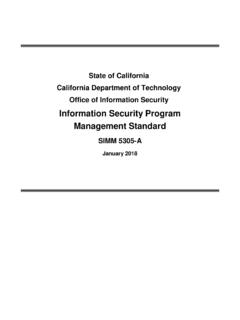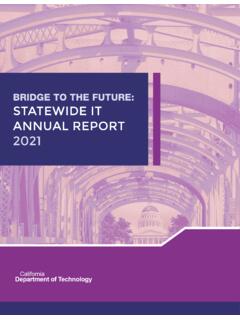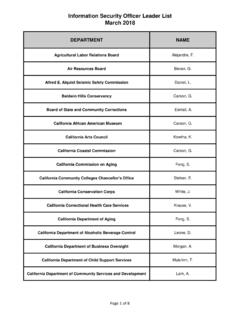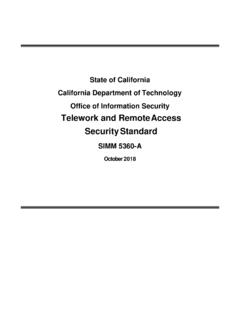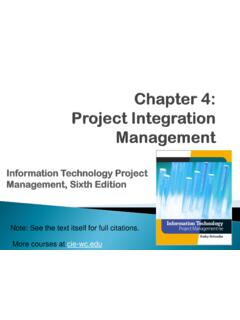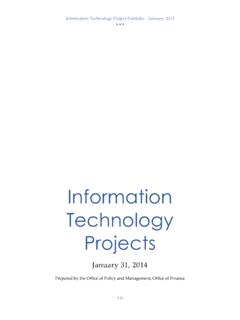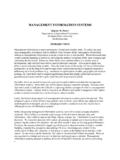Transcription of Information Technology Project Oversight …
1 State of California Department of Technology Information Technology Project Oversight framework SIMM Section 45 Revised April 2017 .. 3 ..3 .. 3 .. 3 .. 4 .. 5 .. 5 .. 5 .. 5 .. 6 .. 6 .. 6 .. 7 .. 9 .. 11 .. 12 .. 13 Table of Contents INTRODUCTION Project CLASSIFICATIONP roject Complexity AssessmentProject management Risk Assessment Oversight PROTOCOLOVERSIGHT FOCUS AREASRisk management Project ManagementTechnical/System DevelopmentREPORTING AND ESCALATIONP roject Status ReportIndependent Project Oversight ReportCorrective Action Plan (CAP)Table 3: Escalation PathPROJECT Oversight framework COMPONENTSSUMMARY OF TEMPLATES AND INSTRUCTIONSAPPENDIX A: CATEGORIES AND EXAMPLES OF RISKC alifornia Department of Technology IT Project Oversight framework SIMM Section 45 April 2016 Introduction Pursuant to Government Code (GC) Sections 11545 and 11546, the California Department of Technology (CDT) is responsible for the approval and Oversight of IT projects, which includes establishing and enforcing policies for Information Technology (IT) projects.
2 Per State Administrative Manual (SAM) Section , Project Oversight is defined as A n independent review and analysis to determine if the Project is on track to be completed within the estimated schedule and cost, and will provide the functionality required by the sponsoring business entity. Project Oversight identifies and quantifies any issues and risks affecting these Project components. Independent Project Oversight is a process that begins immediately following Project approval and continues through Project closeout. The IT Project Oversight framework applies to all reportable projects as defined in SAM Section and describes the criteria that CDT will use to assess the risk, sensitivity and level of criticality and Oversight for IT projects. Oversight requirements identified in this framework emphasize risk identification and reporting, along with the need for independent review of the minimum set of practices and products described herein.
3 Although this framework primarily addresses Independent Project Oversight practices, Independent Verification and Validation (IV&V) requirements are also identified. Project Classification Project Complexity Assessment As part of the Project Approval Lifecycle (PAL), CDT will evaluate each proposed Project to determine the level of Project Oversight needed on a given Project . When Agency/state entities submit new Project proposals for approval, the Complexity Assessment tool (SIMM Sections 45C and 45D) is used to assess the complexity of the Project on the two most common dimensions (business complexity and technical complexity) consisting of a series of attributes. Typical business attributes include size, geography, interaction with other departments and entities, impact to business processes, and financial risk. Typical technical attributes include level of Technology integration, security needs, stability of hardware/software, and team experience.
4 The complexity assessment is based upon CDT s extensive breadth of historical experience including lessons learned with projects and its enterprise view of the state s IT portfolio. CDT s assessment will place each individual Project into one of three categories (low, medium, or high). Per SAM Section 4940, all medium and high criticality projects will receive independent Oversight from CDT, Oversight for low criticality projects will be provided at the discretion of CDT. Project management Risk Assessment Additionally as part of PAL, CDT will evaluate the Project management maturity of the Agency/state entity and its ability to carry out projects. The Project management Risk Assessment (SIMM Sections 45A and 45B) will assess the Project management capability and degree to which the IT Project has established and used minimum Project management practices, processes and deliverables documented in the California Project management framework (CA-PMF).
5 As part of this assessment, CDT s Independent Project Oversight (IPO) manager may interview the appropriate Agency/state entity IT management and staff, review Project documents, and continually observe the Project team and Project activities to determine the degree to which the requirements are being met. California Department of Technology Page 3 IT Project Oversight framework SIMM Section 45 April 2017 The Project management Risk Assessment will evaluate such elements as: Organizational commitment to a well-defined, mature Project management process Existence of predicated management commitment, functions, and systems Competence of participants in any Project management endeavor Organizational Project management environment ( , tools, infrastructure) and how well these are integrated Measurement metrics in the organization and how well they are used and any applicable past performance Organization s continuous improvement process Oversight Protocol In order for CDT to effectively carry out the responsibility of providing approval and Oversight of IT projects, state entities are required to.
6 Take timely action to ensure that the IPO engagement begins on the Project start date and continues through the duration of the Project unless other direction is provided by CDT Provide timely access to Agency/state entity Project , program, and IT management and staff Provide timely access to Project related Information , documents, repositories, tools, and reports Provide transparency and access to Project related communications, meetings, and activities Provide appropriate notice and access to Project related meetings Provide timely responses and resolution, if applicable, to IPO and IV&V observations and findings Provide IPO staff the opportunity to discuss and report IPO related Information to Project managers/directors, steering committee members, Project sponsors, etc. Participate in periodic meetings with IPO staff to discuss IPO related Information and reports Review draft IPO reports and provide feedback on inaccuracies to IPO staff Promptly submit requested and required Information to CDT and/or IPO staff in accordance with Sam California Department of Technology Page 4 IT Project Oversight framework SIMM Section 45 April 2017 Oversight Focus Areas Risk management CDT has placed a significant emphasis on risk management as a critical function of Project Oversight .
7 The IPO manager must identify and quantify any issues and risks, and provide notification as appropriate. Furthermore, Project managers are expected to establish suitable remediation plans for identified Project risks. All projects should formally review risks at least monthly. Risks should be reviewed by a group of individuals representing all components of the Project organization to ensure identification of all risks. SIMM Section 17, CA-PMF Risk management Plan, Section contains the minimum requirements for risk management , to be implemented on all IT projects. See Appendix A for categories and examples of risk in addition to that which is included in the CA-PMF. Project management As part of the Oversight process, CDT will evaluate the demonstrated degree to which the Agency/state entity has established Project management practices and processes to support successful IT projects. The CA-PMF establishes statewide standards for Project management and forms the minimum requirements for IT Project management for Agency/state entities required to comply with SAM Section 4800 and 4900 policies.
8 See SAM Section 4910 for Project management requirements. These practices and processes will be used to assess and evaluate Agency/state entity performance in Project management and define the IT structure and environment components used to assess Agency/state entity Project management maturity. The required set of practices and products is tailored to the three categories of Project criticality (low, medium, or high). All Project management practices, processes and deliverables must meet the minimum level of planning required in the CA-PMF. The IPO Manager shall use the checklist located in SIMM Section 45I to conduct reviews to ensure compliance. For each item on the template, the IPO Manager will identify the document(s) or other Project products that demonstrate performance of the required functions. The IPO Manager will review and assess the identified items for completeness, currency, comprehensiveness, accuracy and any other attributes pertaining to their quality and appropriateness for their intended function.
9 There is a separate template for each level of Project criticality (low, medium and high). The template should be employed as a checklist, with the team noting the result of the assessment and the principle sources of input to the assessment process. For any item found to be deficient, the deficiency must be documented separately as a finding within the IPO Manager s written report. Agencies/state entities may require additional Oversight reporting, beyond that required by this framework . The documentation of additional Information beyond that included in SIMM Section 45G and 45H may be added as a supplemental document to the standard reporting format. Technical/System Development Although overall Project Oversight will be provided by the IPO Manager, Independent Validation and Verification will be used to supplement IPO. The roles of Independent Project Oversight (IPO) differs from Independent Validation and Verification (IV&V). IPO focuses on Project management processes and deliverables ( plans, schedules, risks & issues) while IV&V focuses on the technical assessment of the system s development and deliverables to determine if the user requirements, product quality, and specifications are met.
10 Within IV&V, the term verification refers to the process of evaluating software to determine whether the products of a given development phase satisfy the conditions imposed at the start of that phase. [IEEE-STD-610]. The term validation refers to the process of evaluating software during or at the end of the development process to determine whether it satisfies specified requirements. [IEEE-STD-610]. Agencies/state entities must comply with the requirements of SAM Section when utilizing IV&V services. California Department of Technology Page 5 IT Project Oversight framework SIMM Section 45 April 2017 Reporting and Escalation It is the intent of the CDT to appropriately and efficiently identify, report and escalate Project observations, risks, and issues that are believed to present substantial risk to a Project which may, if not corrected timely, lead to severe negative consequences to the Project outcomes, scope, schedule, or quality.
